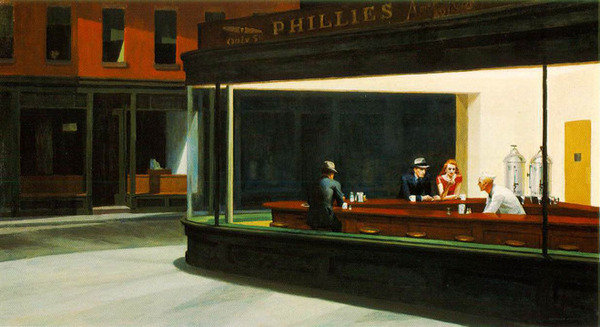Edward Hopper
dal 9/10/2012 al 27/1/2013
Segnalato da
9/10/2012
Edward Hopper
Galeries nationales du Grand Palais, Paris
Whether they express deep poignancy or explore figments of the imagination, these paintings have been interpreted in the most contradictory ways. A romantic, realist, symbolist and even formalist, Hopper has been enrolled under every possible banner. The exhibition at the Grand Palais seeks to shed light on this complexity, which is an indication of the richness of Hopper's oeuvre.

Paintings by Edward Hopper (1882-1967) have the deceptive simplicity of myths, a sort of picture-book obviousness. Each one is a concentrate of the hypothetical knowledge and dreams conjured up by the fabulous name of America. Whether they express deep poignancy or explore figments of the imagination, these paintings have been interpreted in the most contradictory ways. A romantic, realist, symbolist and even formalist, Hopper has been enrolled under every possible banner. The exhibition at the Grand Palais seeks to shed light on this complexity, which is an indication of the richness of Hopper’s oeuvre.
It is divided chronologically into two main parts: the first section covers Hopper’s formative years (1900-1924), comparing his work with that of his contemporaries and art he saw in Paris, which may have influenced him. The second section looks at the art of his mature years, from the first paintings emblematic of his personal style, House by the Railroad (1924), to his last works, Two Comedians (1966).
Hopper entered Robert Henri’s studio at the New York School of Art in the early years of the twentieth century. Henri was a colourful figure; in 1908, he founded the Ashcan School, whose very name was a statement of the uncompromising realism of its most radical members. Hopper’s time in Paris (nearly a year in 1906, followed by shorter stays in 1909 and 1910) offers an opportunity to compare his paintings with those he saw in the city’s galleries and salons. Degas inspired him to take original angles and apply the poetic principle of dramatisation. The massive structure of his views of the quays of the Seine was borrowed from Albert Marquet. He shared with Félix Vallotton a taste for light inspired by Vermeer. Walter Sickert was his model for the iconography of theatres and paintings of damned flesh. In Paris, Hopper adopted the style of Impressionism, a technique which he felt had been invented to express harmony and sensual pleasure.
Back in the United States he absorbed the gritty realism of Bellows or Sloan, that of the Ashcan School, whose dystopic vision he shared. He earned his living doing commercial illustrations, which will be presented in the Paris exhibition. But it was his etchings (from 1915) that brought about a metamorphosis in his work and crystallized his painting, as he put it. One room in the exhibition is devoted to his etchings.
1924 was a turning point in Hopper’s life and career. The exhibition of his watercolours of neo-Victorian houses in Gloucester, in the Brooklyn Museum and then in Franck Rehn’s gallery, brought him recognition and commercial success which enabled him to work full time on his art (he had previously sold only one painting, at the Armory Show in 1913).
Hopper’s watercolours open the second major section of the exhibition, which shows the American artist’s emblematic paintings and iconography. The chronological presentation permits visitors to appreciate the continuity of his inspiration, the way he explored his favourite subjects: houses infused with a near “psychological” identity, House by the Railroad, 1924, solitary figures sunk in thought, Morning Sun, 1952, the world of the theatre, Two on the Aisle, 1927, images of the modern city, Nighthawks, 1942.
The apparent realism of Hopper’s paintings, the abstract mental process that prevails in their construction, destined these works to the most contradictory claims. The bastion of the American realist tradition, the Whitney Museum of Art, regularly showed his work. And yet it was the MoMA of New York, the temple of Formalism, which gave him his first retrospective, in 1933. The MoMA’s director, Alfred Barr, hailed an artist whose compositions were often interesting “from a strictly formal point of view.” The complexity of Hopper’s oeuvre puts it at the intersection of the two historical definitions of American modernity: one derived from the Ashcan School which claimed the Baudelairian principle of modernity linked to the subject, and the other taken from the lessons of the Armory Show which, in 1913, revealed the formalism of European avant-gardes (cubism and cubist futurism) to the American public. In the fifties, the surreal strangeness, and “metaphysical” dimension of Hopper’s painting led to comparisons with De Chirico. At the same time, in the columns of the magazine Reality, the painter joined American realist artists in denouncing abstract art, which, in their view, was submerging collections and museums.
Only a few months after the artist’s death, the curator of the American section of the Sao Paulo Biennale, Peter Seltz, reconciled realism and avant-garde art by organising an exhibition of Hopper’s works in conjunction with paintings by the Pop Art generation.
Image: Edward Hopper, Nighthawks, 1942 © Art Institute of Chicago
Press contact: Florence Le Moing - florence.lemoing@rmngp.fr - presse@grandpalais.fr
Galeries nationales (Grand palais, Champs-Elysées)
3, avenue du Général Eisenhower 75008 Paris
Opening hours: Thursday, Saturday, noon – 8 PM Friday, noon – 9:30 PM Sunday, noon – 7 PM
Admission fee Full rate €24.00 — Concessions €12.00



